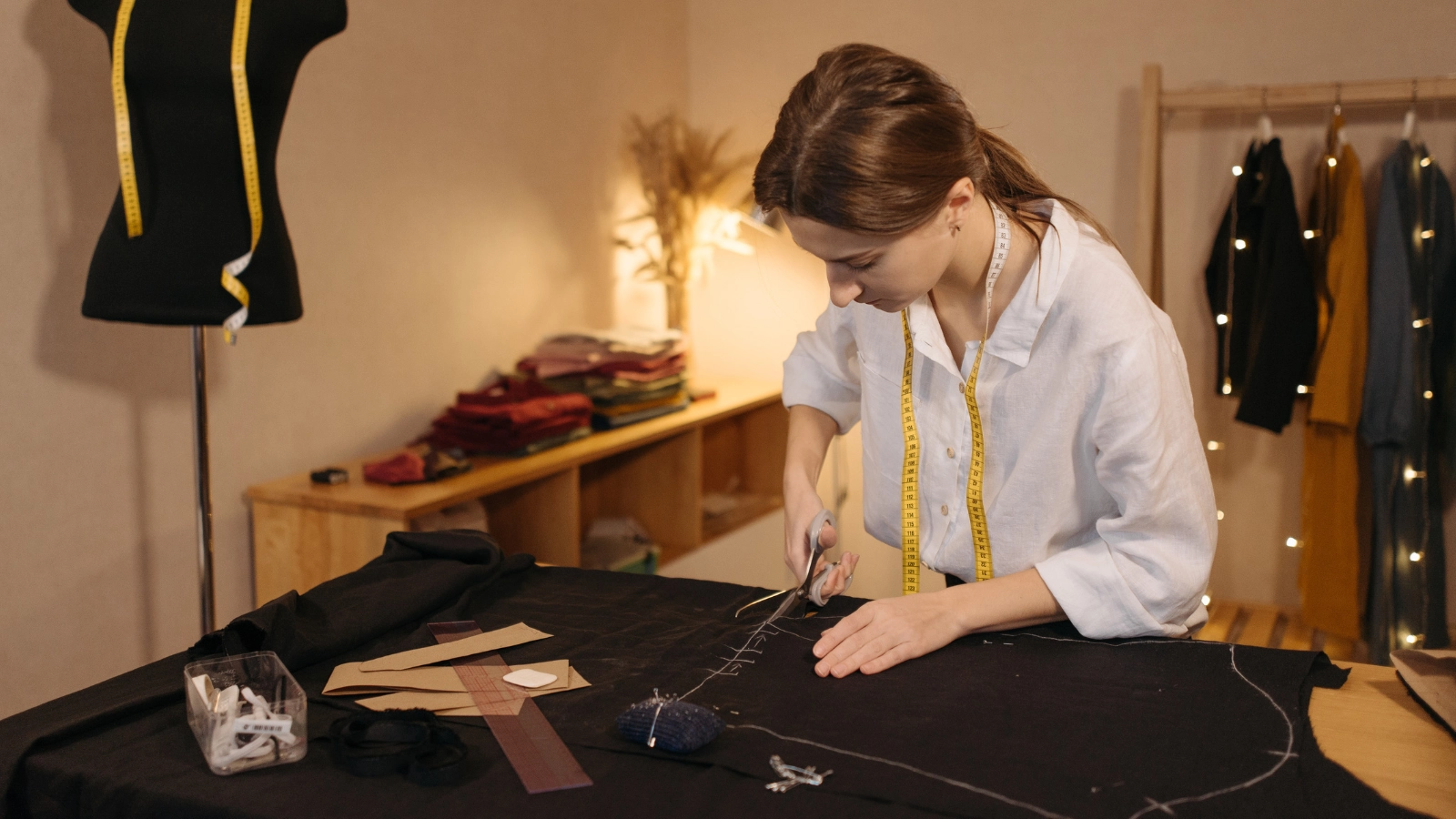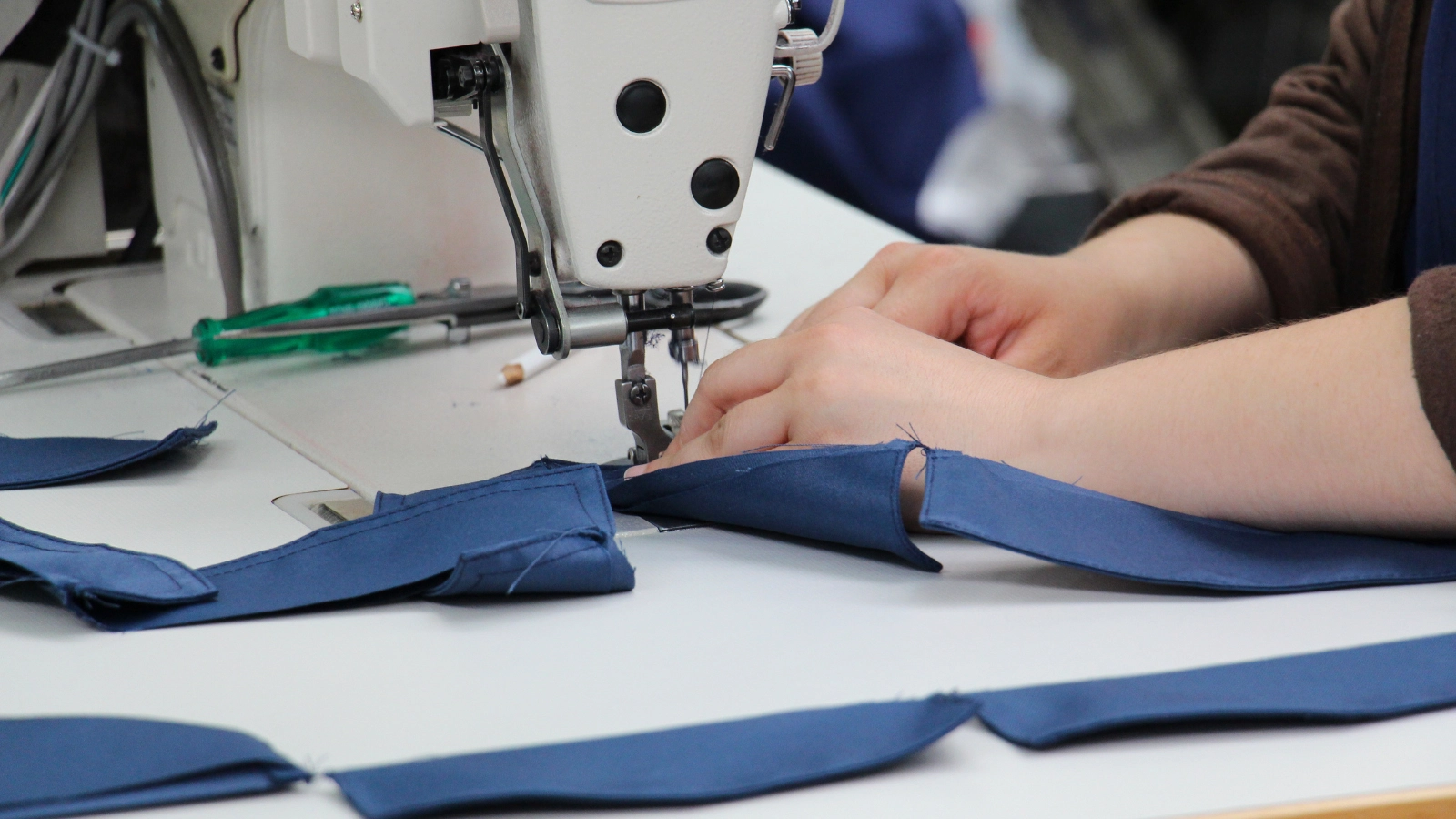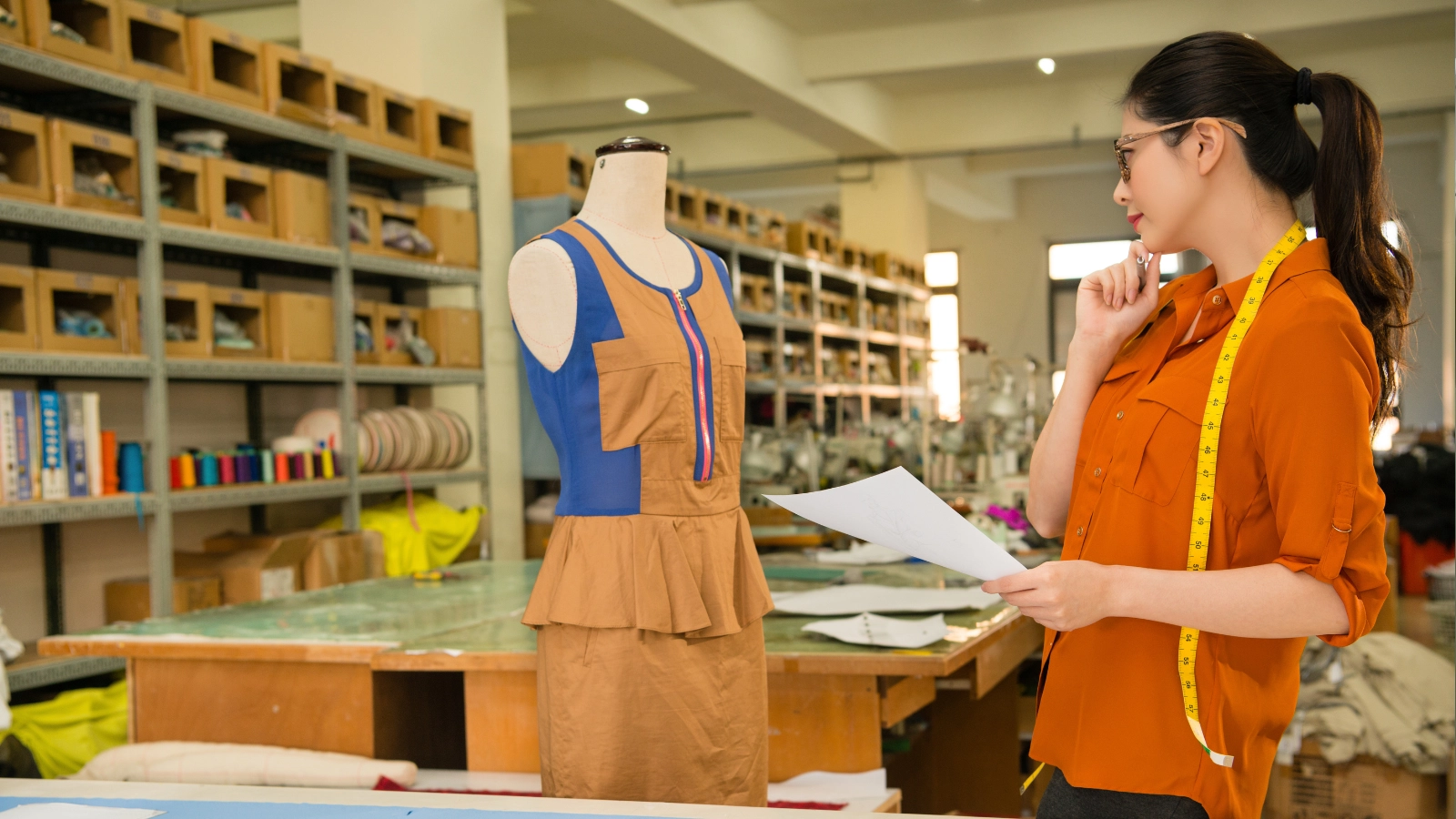When learning to sew a garment, you need to be both precise and creative. Every step in a garment construction plan requires careful attention and knowledge of how textiles work.
Modern methods have advanced beyond basic hand-sewing, using new tools and techniques. However, the basic principles of putting garments together are still the same. These form the foundation for making everything from simple shirts to complex fashion designs.
Key Takeaways
- Clothing construction begins with precise pattern-making, accurate measurements, and proper fabric selection.
- Essential sewing techniques include mastering basic stitches, consistent seam allowances, and proper seam finishes.
- Fabric grain alignment and careful cutting are crucial for structural integrity.
- Quality control thoroughly inspects stitching, seams, hems, and overall construction.
- Finishing includes proper pressing, secure closure installation, and clean edge treatments.
The History of Garment Construction

Humans have made clothing since prehistoric times. But clothing construction techniques have changed dramatically over the years.
Early sewing methods are seen in ancient Egyptian, Chinese, and Roman societies. At that time, they developed advanced clothing-making techniques with simple tools.
The Industrial Revolution changed how fabrics were made. Machines allowed for standardized sizes and mass production.
In the 20th century, synthetic fabrics emerged, providing better durability and easy care.
Today, technology like CAD systems further improves the accuracy of garment creation.
Basic Principles of Garment Construction
Let's inspect the fundamental concepts that guide making clothing.
Fabric Selection
Choosing the right fabric is crucial for successful garment construction. It affects the garment's quality, drape, comfort, and durability.
When planning your garment, evaluate the fabric's weight, stretch, and breathability. Doing so will ensure it matches your design.
Align the fabric grain lines with the pattern pieces to avoid distortion and keep the structure intact.
Think about how the fabric will hold up during wear and care, as this affects durability. The fabric should support both the intended use and the look of your design.
Pattern Making
Pattern making is the blueprint for garment construction. It requires precise measurements and technical skills.
When drafting patterns, don't forget to account for seam allowances. This ensures fabric pieces fit together correctly.
Successful pattern drafting relies on understanding construction methods and how they affect the desired silhouette.
Whether using traditional methods or modern software, consider the fabric's properties, such as grain, stretch, and drape.
This attention to detail ensures your finished garment meets the intended design and fit.
Cutting Techniques
Mastering cutting techniques is essential for successful garment construction. Ensure fabric pieces are laid flat and securely pinned while cutting.
Pay attention to the fabric grain. Misalignment can affect drape and fit. For precise edges, use sharp scissors or a rotary cutter.
Include proper seam allowances while cutting. This is crucial for successful stitching and finishing. The quality of your cutting directly affects how well your pieces fit together during assembly.
Garment Construction: Sewing Techniques

With the foundation laid, it’s time to dive into the various methods used in garment construction.
Types of Stitches
Choosing the right stitches is essential for successful garment making. Collars, cuffs, and darts must be accurately crafted and securely stitched. About 30 stitch types serve different purposes in clothing creation. Here are some common stitches you can learn:
- Straight Stitch: This is the most basic stitch, used for seams and hems. It's a simple, straight line of stitching.
- Zigzag Stitch: Used for finishing edges to prevent fraying. It's effective for stretch fabrics.
- Backstitch: A strong stitch often used for hand-sewing seams. It creates a solid line of stitching.
- Basting Stitch: A temporary stitch used to hold layers of fabric together before final stitching.
- Overlock (Serger) Stitch: Used to finish edges of fabric. A serger machine creates this stitch and prevents fraying.
- Blind Hem Stitch: Used for hemming without visible stitches on the front side of the fabric.
- French Seam: A method of enclosing raw edges within the seam, providing a neat finish.
- Flat-Felled Seam: A strong seam often used in denim and workwear. It encloses raw edges and adds durability.
- Lapped Seam: A seam where two pieces of fabric overlap, commonly found in denim and heavy fabrics.
- Chain Stitch: Typically used in decorative sewing and is known for its flexibility.
Sewing Methods
With the right stitches, advanced sewing methods raise garment construction to professional standards.
You’ll master three key techniques for quality clothing. The Flat-Felled Seam is ideal for denim due to its durable double-folded construction. The French Seam hides raw edges by enclosing them within the seam. The Tailored Edge Seam provides a polished finish through precise facing application.
Each technique has a specific purpose in the sewing process. Knowing when to use these methods will elevate your creations to professional-grade pieces.
Garment Construction: Finishing Techniques
Next, let's examine various finishing methods. They are also crucial to the overall appearance and durability of clothing.
Hemming and Edging
Hemming and edging techniques are the crucial final step in making clothes. They affect both durability and appearance. Here are some basic hemming and edging methods:
- Double Fold Hem: Fold the raw edge of the fabric up by a specified width. Then, press and fold it up again to enclose the raw edge. Stitch along the folded edge.
- Single Fold Hem: Fold the raw edge up once and stitch it in place. This method is great for fabrics that do not fray much.
- Blind Hem: The hem is folded up, and a special blind hem stitch attaches it so that the stitches are almost invisible from the outside.
- Serged Hem: Use a serger (overlock machine) to finish the raw edge and create a hem in one step. This method can also be used for knits.
- Bias Binding Hem: A strip of bias-cut fabric is sewn around the raw edge, enclosing it completely. This creates a decorative design.
- Rolled Hem: The raw edge is rolled up and stitched close to the edge. A rolled hem foot can be used for easier application.
- Faced Hem: A facing is applied to the hem instead of folding the raw edge. This is especially useful for heavier fabrics.
Add Closures
Installing closures turns a basic garment into a functional piece. It requires careful placement and attention to detail.
- Choose the right zippers based on your garment's weight. Opt for lightweight nylon or heavy-duty metal.
- When adding buttons, space them 4-6 inches apart, considering fabric stretch and design elements.
- To incorporate a waistband, ensure it complements the style of the garment.
Factor in seam allowances during closure placement, as they affect the final fit. Proper installation techniques are vital. Use a seam ripper for clean buttonholes and reinforcing stress points.
These steps ensure your closures look professional and function well.
Pressing and Steaming
Proper pressing and steaming turn a well-made garment into a polished, professional piece.
Apply heat and pressure strategically throughout the construction process. Adjust your iron's temperature based on the fabric type. Synthetics need lower heat than natural fibers.
Use a pressing cloth to protect delicate materials from direct heat and avoid unwanted shine. Allow steam to penetrate the fibers to relax them and remove wrinkles.
Press all darts, tucks, pleats, or gathers. This careful approach ensures a superior finish.
Quality Control in Garment Construction

Quality control plays a crucial role. It ensures the durability and reliability of garments.
Standards for Garment Quality
Adhering to strict quality standards is essential for successful garment construction.
- Implement thorough quality control measures, starting with fabric inspections before cutting.
- Maintain precise seam allowances of 1/4 to 5/8 inch to ensure your garment's structural integrity.
- During production, conduct fitting trials to assess comfort and movement, making necessary adjustments.
- Use proper finishing techniques, including interfacing and secure closures, to improve durability.
- Before completion, perform final inspections. Check for uniform stitching, pattern alignment, and loose threads.
These standards ensure your garment meets professional and consumer expectations.
Common Defects and How to Identify Them
Identifying defects early prevents costly mistakes and ensures good quality control.
- Inspect garment pieces for misaligned seams by checking pattern alignment and seam allowances.
- Look for fabric puckering along seams. This may indicate improper tension or uneven fabric feeding.
- Examine finishing techniques for poorly executed hems and untrimmed threads.
- Test closures for proper alignment and spacing. Make sure buttons and zippers work smoothly.
- Finally, verify hem lengths. Measure from a fixed point to ensure uniform measurements on all sides.
Advanced Garment Construction Techniques
Traditional methods provide a strong foundation. But exploring advanced garment construction techniques opens up new creative possibilities.
Innovative Construction Methods
Modern technology has transformed traditional garment construction methods. It brings precision-driven techniques that enhance efficiency and quality.
Advanced techniques now use laser cutting technology. This works well for unmatched accuracy in fabric preparation and intricate pattern execution.
Bonded seams and ultrasonic welding are replacing conventional stitching. They can create seamless, waterproof garments.
Digital pattern making and 3D garment simulation improve fit precision.
Innovative seam techniques like flatlock and coverstitch offer superior performance in activewear production.
Sustainable Practices
Recent technological innovations have made sustainability a key focus in advanced garment construction.
Eco-friendly materials like organic cotton and recycled polyester are at the forefront. They significantly reduce environmental impact.
Zero-waste pattern design maximizes fabric use. Meanwhile, local production strengthens community economies and reduces transportation emissions.
Use energy-efficient machinery in the manufacturing facilities. Ensure it's powered by renewable sources to improve sustainability.
When combined with consumer education on proper garment care, these practices create a well-rounded approach to sustainable garment making.
Conclusion
Modern garment construction blends traditional craftsmanship with technological precision. Strictly follow dimensional accuracy, seam allowances, and fabric grain. Meanwhile, use advanced CAD systems and automated cutting processes.
Integrate sophisticated finishing methods with careful quality control protocols to ensure structural integrity. Master these elements, and you'll consistently produce high-quality garments.
Learn more sewing tips on the Longan Craft Blog, and dive into the fabric world with Longan Craft!
FAQs
What Is Garment Construction?
You'll transform fabrics into wearable clothing through precise steps: designing, pattern making, cutting, sewing, and finishing. This meticulous process requires technical expertise in both hand and machine methods.
What Are the 8 Stages of Garment Construction?
You'll follow these eight stages: designing the concept, creating patterns, cutting fabric, sewing pieces together, adding functional features, finishing, pressing for shape, and final assembly of the garment.
What Are the Principles of Garment Construction?
You'll need to follow five key principles: design (both aesthetic and functional), pattern making (precise measurements), structural integrity (seams and support), material selection (suitability of fabrics), and finishing techniques (for a professional appearance and durability).


0 comments